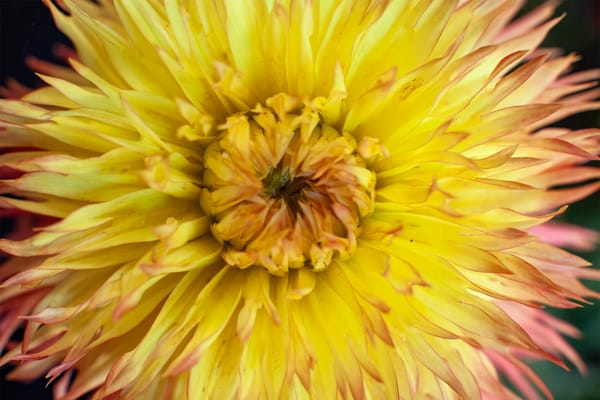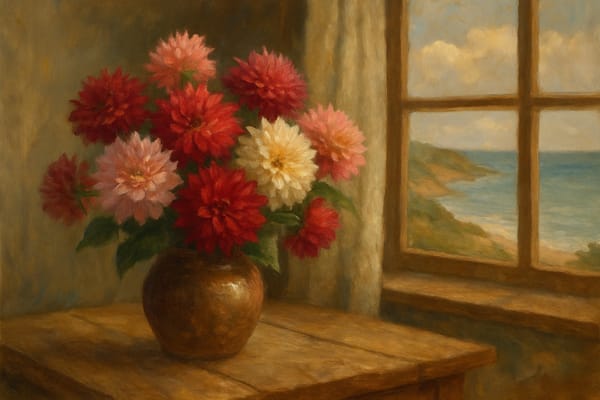The Flower That Found a Home in Cornwall
Dahlias arrived on British shores in the 19th century, carried by the tides of Victorian horticultural curiosity—and few places embraced them like Cornwall. With its gentle climate, long growing season, and a community of passionate growers, Cornwall quickly became a heartland for dahlia cultivation, blending global botanical heritage with local innovation.
The Victorian dahlia craze swept across the nation, but in Cornwall it met fertile ground. Country estates, from Heligan to Tregothnan, showcased the latest floral fashions, while local horticultural societies staged increasingly ambitious competitions. The region’s mild maritime climate allowed dahlias to flourish well into autumn, delighting both Victorian audiences and contemporary gardeners alike.
The Rise of the Cornish Dahlia Society and Local Breeders
Founded in 1981, the Cornish Dahlia Society became the nucleus of Cornwall’s competitive dahlia scene. With a mission to promote excellence in growing and exhibiting, the Society nurtured both amateur enthusiasts and celebrated breeders—many of whom left a lasting mark on British horticulture.
Notable Cornish Breeders and Their Cultivars:
- Cyril Watkins — creator of the renowned Polventon Supreme (yellow small ball) and Polventon Kristobel (pink miniature decorative), both multiple award winners.
- David Jasper — known for Jazzy Bee and Tiggy Bee, plus the striking Kernow Sen Lorraine and Kernow Sen Tetha—all favorites on the show bench.
- Harold Wilkinson — raised Gurtla Twilight, a classic pompon still coveted by exhibitors.
- Phil Burden — bred May B, a small ball variety celebrated for its form and performance.
- Ray Adley — responsible for Mabel Anne, a giant decorative dahlia that made waves on the national stage.
- Peter Greenway — creator of the Josudi series, known for precision-bred pompons and semi-cactus forms.
These breeders didn’t just craft beautiful flowers—they anchored Cornwall at the forefront of dahlia development, with many of their varieties still grown in gardens and showcased at national competitions today.
Cornwall’s Living Dahlia Heritage: The National Dahlia Collection
While Cornwall’s growers made headlines, its greatest horticultural treasure may be the National Dahlia Collection. Originally founded in Oxfordshire in the 1980s, the collection found a permanent home in Cornwall under the stewardship of David Brown. First at Duchy College Rosewarne, later at Varfell Farm near Penzance, the collection grew into a living archive of over 1,700 cultivars and 22 species.
In 2021, following a critical turning point, the collection was saved by horticulturist Louise Danks and a dedicated team of volunteers, securing its future at the Kehelland Trust. Today, it stands as a testament to Cornwall’s enduring role in dahlia conservation and education, open to the public and playing a pivotal role in preserving floral biodiversity.
Cornish-Bred Cultivars: A Showcase of Regional Distinction
Cornwall’s dahlias are known for more than their show-winning pedigree—they reflect the climate, character, and creativity of the region.
Key features of Cornish cultivars include:
- Weather resilience — bred for strong stems and reliable bloom in Cornwall’s often blustery conditions.
- Extended flowering — thriving into the late Cornish autumn, offering vivid color when many other flowers fade.
- Showbench appeal — with saturated colors, symmetrical blooms, and strong stems ideal for exhibition.
Notable varieties carry local pride in their names—Polventon, Kernow, Josudi, Gurtla—linking them forever to Cornwall’s horticultural heritage.
Cornwall’s Victorian Horticultural Heritage: Setting the Scene
The Victorian era was a golden age for Cornish horticulture. Great estates like Heligan, Trengwainton, and Tregothnan turned Cornwall into a testing ground for exotic plants brought back by intrepid plant hunters like the Lobb Brothers. Their introductions of rhododendrons, magnolias, and tree ferns forever altered the Cornish landscape.
Dahlias thrived in this environment. Victorian glasshouses, kitchen gardens, and show borders became stages for these flamboyant blooms. Competitive shows—many still running today—became part of Cornish cultural life, giving rise to a tradition of excellence that persists in both private gardens and public exhibitions.
A Living Legacy: Preserving Cornwall’s Dahlia Heritage
Today, Cornwall’s dahlia heritage is alive in garden borders, competition benches, and community shows. The National Dahlia Collection safeguards rare varieties; the Cornish Dahlia Society fosters new breeders and inspires gardeners; and events like the Heligan Dahlia Show draw visitors from across the country.
Cornwall’s contribution is not just historical—it’s living, dynamic, and vital. The county remains a beacon for those who love dahlias, blending Victorian heritage with modern innovation.
For gardeners, planting Cornish-bred dahlias means growing a piece of this legacy—a flower born of passion, nurtured by community, and rooted in one of Britain’s most distinctive horticultural traditions.











